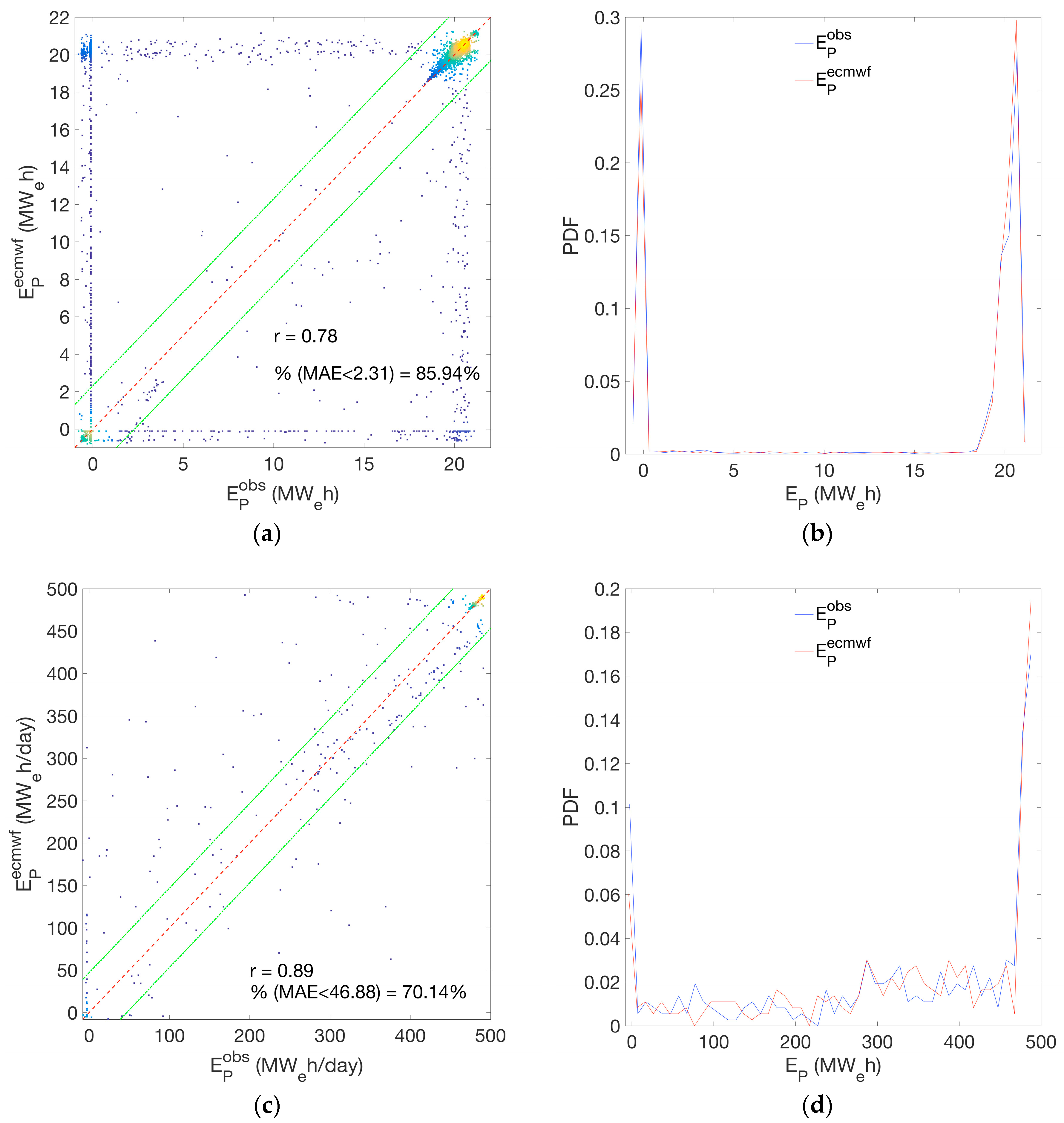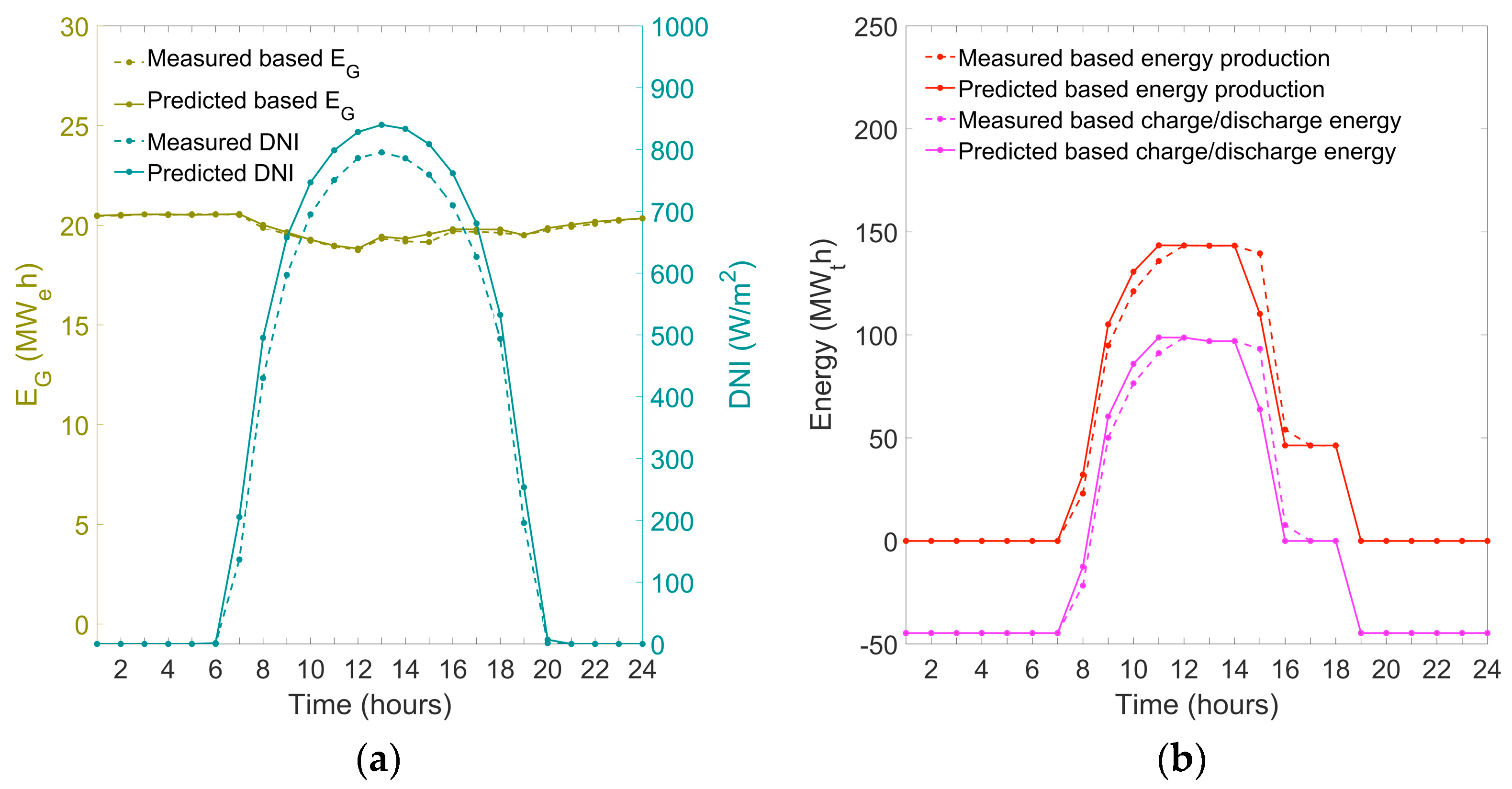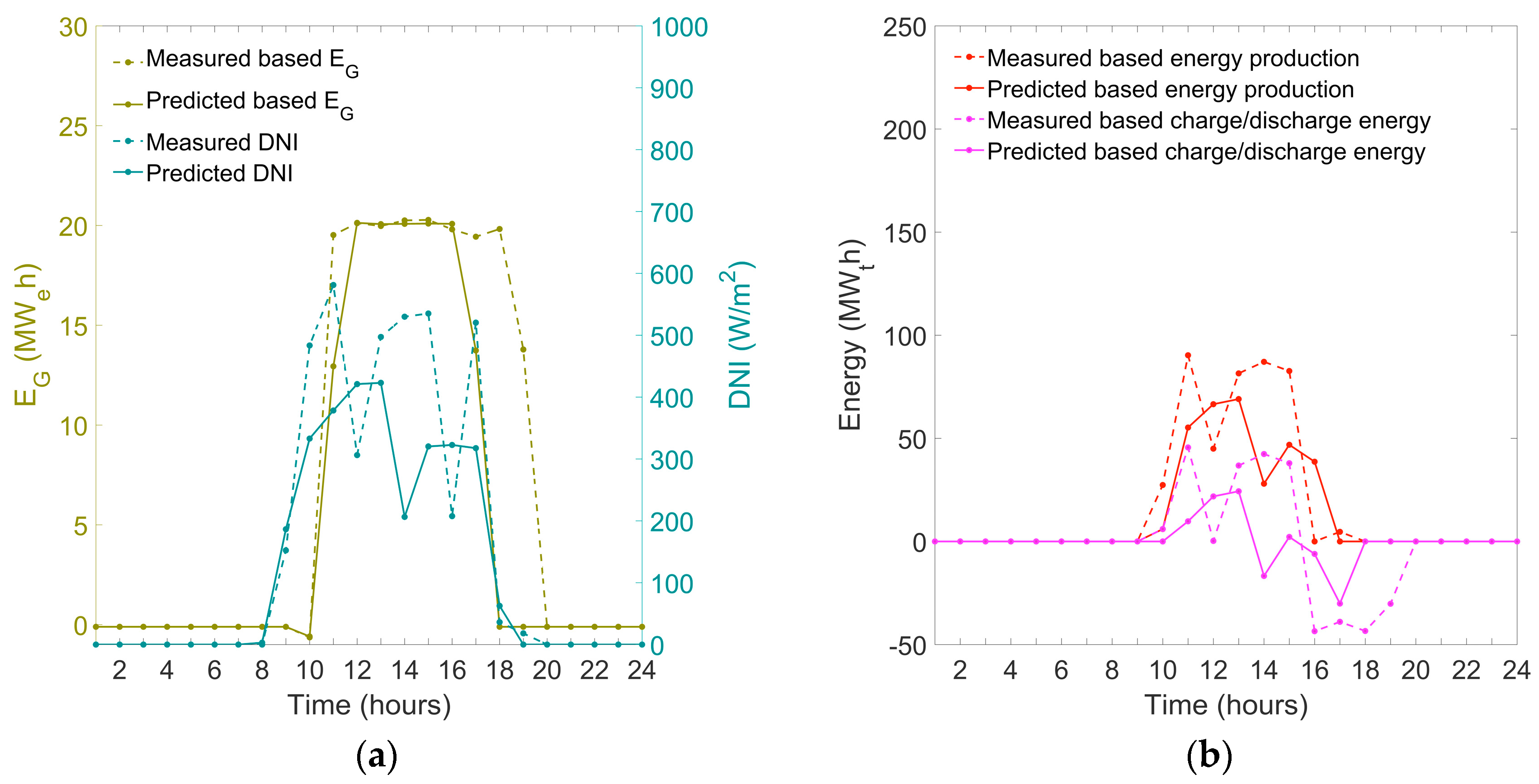Short-Term Forecasts of DNI from an Integrated Forecasting System (ECMWF) for Optimized Operational Strategies of a Central Receiver System
Abstract
:1. Introduction
2. Data and Methodology
2.1. Measurements
2.2. Forecasts
2.3. CSP Plant Model
3. Results and Discussion
4. Operational Strategies for Typical Days
4.1. Clear Sky Days
4.2. Cloudy Days
4.3. Overcast Days
5. Conclusions
Author Contributions
Funding
Acknowledgments
Conflicts of Interest
Appendix A

| General | ||
|---|---|---|
| Name | Value | Reference |
| Single heliostat net area | 115.7 m² | [42] |
| Ratio of reflective area | 0.9642 | [42] |
| Field gross collecting area | 315,000 m2 | 2625 heliostats generated by SAM, 2650 according to [42] |
| Irradiation at design | 700 W/m2 | Chosen by authors |
| HTF | Solar Salt | [36] |
| Design loop inlet temperature | 290 °C | [36] |
| Design loop outlet temperature | 565 °C | [36] |
| Full load hours of TES | 15 h | [36] |
| Storage HTF fluid | Solar Salt (direct storage) | [36] |
| Receiver | ||
| Name | Value | Reference |
| Tower height | 140 m | [36] |
| Receiver height | 10 m | [42] |
| Receiver diameter | 9 m | [42] |
| Number of panels | 14 | Chosen by authors |
| Tube outer diameter | 4 × 10−2 m | SAM standard value |
| Minimum receiver turndown fraction | 0.25 | SAM standard value |
| Maximum receiver operation fraction | 1.2 | SAM standard value |
| Receiver startup delay time | 0.25 h | Chosen by authors |
| Estimated receiver heat loss | 30 kW/m2 | Calculated by authors (Equation (A5)) |
| Piping length | 360 m | Estimated by authors |
| Piping heat loss coefficient | 1000 Wt/m | Calculated by authors (Equation (A7)) |
| Power block | ||
| Name | Value | Reference |
| Design gross output | 19.9 MWe | [36] |
| Gross to net conversion factor | 1 | [36] |
| Rated cycle conversion efficiency | 0.445 | Calculated from storage and receiver capacities |
| Fraction of thermal power needed for standby | 0.2 | SAM Standard value |
| Power block start-up time | 0.5 h | SAM Standard value |
| Fraction of thermal power for start-up | 0.5 | SAM Standard value |
| Maximum turbine over design operation (ratio) | 1.05 | SAM Standard value |
| Minimum turbine operation (ratio) | 0.2 | SAM Standard value |
| Boiler operating pressure | 105 bars | [43] |
| Turbine inlet pressure control | Fixed-pressure | SAM Standard value |
References
- Mendelshon, M.; Lowder, T.; Canavan, B. Utility-Scale Concentrating Solar Power and Photovoltaics Projects: A Technology Market Overview; Technical report NREL/TP-6A20-51137; NREL U.S. Department of Energy: Washington, DC, USA, 2012.
- Kearney, D.; Kelly, B.; Herrmann, U.; Cable, R.; Pacheco, J.; Mahoney, R.; Price, H.; Blake, D.; Nava, B.; Potrovitza, N. Engineering aspects of a molten salt heat transfer fluid in a trough solar field. Energy 2004, 29, 861–870. [Google Scholar] [CrossRef]
- Coimbra, C.; Kleissl, J.; Marquez, R. Overview of solar forecasting methods and a metric for accuracy evaluation. In Solar Resource Assessment and Forecasting; Elsevier: Waltham, MA, USA, 2013; ISBN 9780123971777. [Google Scholar]
- Schroedter-Homscheidt, M.; Benedetti, A.; Killius, N. Verification of ECMWF and ECMWF/MACC’s global and direct irradiance forecasts with respect to solar electricity production forecasts. Meteor. Zeitschrift 2017, 26, 1–19. [Google Scholar] [CrossRef]
- Stull, R.B. An Introduction to Boundary Layer Meteorology, Chapter 13; Atmospheric Science Programme: Dordrecht, The Netherlands, 1999; ISBN 9027727686. [Google Scholar]
- Conceição, R.; Silva, H.G.; Collares-Pereira, M. CSP mirror soiling characterization and modelling. Sol. Energy Mater. Sol. Cells 2018, 185, 233–239. [Google Scholar] [CrossRef]
- Tyagi, H.; Agarwal, A.K.; Chakraborty, P.R.; Powar, S. Advances in solar energy research. Energy Environ. Sustain. 2019, 1, 48–50. [Google Scholar]
- Troccoli, A.; Morcrette, J.-J. Skill of direct solar radiation predicted by the ECMWF global atmospheric model over Australia. Am. Meteor. Soc. 2014, 53, 2571–2587. [Google Scholar] [CrossRef]
- Tompkins, A.M. The Parametrization of Cloud Cover; European Centre for Medium-Range Weather Forecasts (ECMWF): Reading, UK, 2005. [Google Scholar]
- Bozzo, A.; Remy, S.; Benedetti, A.; Flemming, J.; Bechtold, P.; Rodwell, M.J.; Morcrette, J.-J. Implementation of a CAMS-Based Aerosol Climatology in the IFS; European Centre for Medium-Range Weather Forecasts (ECMWF): Reading, UK, 2017; Volume 801. [Google Scholar]
- Lopes, F.M.; ConceiçÃo, R.; Fasquelle, T.; Silva, H.G.; Salgado, R.; Canhoto, P.; Collares-Pereira, M. ECMWF forecasts of DNI for optimized operation strategies of linear focus parabolic-trough systems. Appl. Energy 2019. In revision. [Google Scholar]
- The Parabolic Trough Power Plants Andasol 1 to 3. The Largest Solar Power Plants in the World—Technology Premier in Europe. Solar Millenium AG. 2008. Available online: http://large.stanford.edu/publications/power/references/docs/Andasol1-3engl.pdf (accessed on 28 March 2019).
- Rinaldi, F.; Binotti, M.; Giostri, A.; Manzolini, G. Comparison of linear and point focus collectors in solar power plants. Energy Proc. 2014, 49, 1491–1500. [Google Scholar] [CrossRef]
- Haiden, T.; Janousek, M.; Bidlot, J.; Ferranti, L.; Prates, F.; Vitart, F.; Bauer, P.; Richardson, D.S. Evaluation of ECMWF Forecasts, Including the 2016 Resolution Upgrade; European Centre for Medium-Range Weather Forecasts (ECMWF): Reading, UK, 2016; Volume 792. [Google Scholar]
- Burgaleta, J.; Arias, S.; Ramirez, D. Gemasolar, the first tower thermosolar commercial plant with molten salt storage. In Proceedings of the 17th SolarPACES Conference, Granada, Spain, 20–23 September 2011. [Google Scholar]
- Salgado, R.; Miranda, P.M.A.; Lacarrère, P.; Noilhan, J. Boundary layer development and summer circulation in Southern Portugal. Tethys 2015, 12, 33–44. [Google Scholar] [CrossRef]
- Cavaco, A.; Silva, H.G.; Canhoto, P.; Osório, T.; Collares-Pereira, M. Progresses in DNI measurements in Southern Portugal. AIP Conf. Proc. 2018, 2033, 1–7. [Google Scholar] [CrossRef]
- International Organization for Standardization. Solar Energy. Calibration of Field Pyrheliometers by Comparison to a Reference Pyrheliometer; ISO 9059:1990(E.); International Organization for Standardization: Genève, Switzerland, 1990. [Google Scholar]
- Long, C.N.; Dutton, E.G. BSRN Global Network Recommended QC Tests 2002, V2.0. Available online: 10013/epic.38770 (accessed on 20 February 2019).
- Mlawer, E.; Clough, S. Shortwave and longwave radiation enhancements in the rapid radiative transfer model. In Proceedings of the 7th Atmospheric Radiation Measurement (ARM) Science team Meeting. U.S. Department of Energy ARM-CONF-970365, San Antonio, TX, USA, 3 March 1997; pp. 409–413. [Google Scholar]
- Hogan, R.J.; Bozzo, A. A flexible and efficient radiation scheme for the ECMWF model. J. Adv. Modell. Earth Syst. 2018, 10, 1990–2008. [Google Scholar] [CrossRef]
- Lara-Fanego, V.; Ruiz-Arias, J.A.; Pozo-Vázquez, A.D.; Gueymard, C.A.; Tovar-Pescador, J. Evaluation of DNI forecast based on the WRF mesoscale atmospheric model for CPV applications. AIP Conf. Proc. 2012, 1477, 317–322. [Google Scholar]
- Voyant, C.; Notton, G. Solar irradiation nowcasting by stochastic persistence: A new parsimonious, simple and efficient forecasting tool. Renew. Sustain. Energy Rev. 2018, 92, 343–352. [Google Scholar] [CrossRef]
- Richardson, W.; Krishnaswami, H.; Vega, R.; Cervantes, M. A low cost, edge computing, all-sky imager for cloud tracking and intra-hour irradiance forecasting. Sustainability 2017, 9, 482. [Google Scholar] [CrossRef]
- Lauret, P.; Voyant, C.; Soubdhan, T.; David, M.; Poggi, P. A benchmarking of machine learning techniques for solar radiation forecasting in an insular context. Sol. Energy 2015, 112, 446–457. [Google Scholar] [CrossRef]
- Aguiar, L.M.; Pereira, B.; Lauret, P.; Díaz, F.; David, M. Combining solar irradiance measurements, satellite-derived data and a numerical weather prediction model to improve intraday solar forecasting. Renew. Energy 2016, 97, 599–610. [Google Scholar] [CrossRef]
- Larson, D.P.; Nonnenmacher, L.; Coimbra, C.F.M. Day-ahead forecasting of solar power output from photovoltaic plants in the American Southwest. Renew. Energy 2016, 91, 11–20. [Google Scholar] [CrossRef]
- Smagorinsky, J.; Miyakoda, K.; Stickler, R.F. The relative importance of variables in initial conditions for dynamical weather prediction. Tellus 1970, 22, 141–157. [Google Scholar] [CrossRef]
- Lopes, F.M.; Silva, H.G.; Salgado, R.; Cavaco, A.; Canhoto, P.; Collares-Pereira, M. Short-term forecasts of GHI and DNI for solar energy systems operation: Assessment of the ECMWF integrated forecasting system in Southern Portugal. Sol. Energy 2018, 170, 14–30. [Google Scholar] [CrossRef]
- Martin, G.M.D.; Johnson, D.W.; Spice, A. The measurement and parameterization of effective radius of droplets in warm stratocumulus. J. Atmos. Sci. 1994, 51, 1823–1842. [Google Scholar] [CrossRef]
- Sun, Z.; Rikus, L. Parameterization of effective sizes of cirrus-clouds particles and its verification against observations. Q. J. R. Meteorol. Soc. 1999, 125, 3037–3055. [Google Scholar] [CrossRef]
- Fu, Q.; Yang, P.; Sun, W.B. An accurate parameterization of the infrared radiative properties of cirrus clouds of climate models. J. Climate Atmos. Sci. 1994, 11, 2223–2237. [Google Scholar] [CrossRef]
- Edwards, J.M.; Slingo, A. Studies with a flexible new radiative code: 1. Choosing a configuration for a large-scale model. Q. J. R. Meteorol. Soc. 1996, 122, 689–719. [Google Scholar] [CrossRef]
- Tegen, I.; Hollrig, P.; Chin, M.; Fung, I.; Jacob, D.; Penner, J. Contribution of different aerosol species to the global aerosol extinction optical thickness: Estimates from model results. J. Geophys. Res. 1997, 102, 895–915. [Google Scholar] [CrossRef]
- Blair, N.; Dobos, A.; Freeman, J.; Neises, T.; Wagner, M.; Ferguson, T.; Gilman, P.; Janzou, S. System Advisor Model, SAM 2014.1.14: General Description; National Renewable Energy Laboratory: Golden, CO, USA, 2014. [CrossRef]
- NREL, Concentrating Solar Power Projects-Gemasolar Thermosolar Plant. Available online: https://solarpaces.nrel.gov/gemasolar-thermosolar-plant (accessed on 27 March 2019).
- Wittmann, M.; Breitkreuz, H.; Schroedter-Homscheidt, M.; Eck, M. Case studies on the use of solar irradiance forecast for optimized operation strategies of solar thermal power plants. IEEE J. Sel. Top. Appl. Earth Obs. Remote Sens. 2008, 1, 18–27. [Google Scholar] [CrossRef]
- Kosmopoulos, P.G.; Kazadzis, S.; Taylor, M.; Athanasopoulou, E.; Speyer, O.; Raptis, P.I.; Amiridis, V. Dust impact on surface solar irradiance assessed with model simulations, satellite observations and ground-based measurements. Atmos. Meas. Tech. 2017, 10, 2435–2453. [Google Scholar] [CrossRef]
- Mukkavilli, S.K.; Prasad, A.A.; Taylor, R.A.; Troccoli, A.; Kay, M. Mesoscale simulations of Australian direct normal irradiance, featuring an extreme dust event. Am. Meteorol. Soc. 2018, 57, 493–515. [Google Scholar] [CrossRef]
- WWRP/WGNE Joint Group on Forecast Verification Research Website on Forecast Verification. Issues, Methods and FAQ. Available online: http://www.cawcr.gov.au/projects/verification (accessed on 28 March 2019).
- Salgado, R. Interacção Solo—Atmosfera em Clima Semi-Árido. Ph.D. Thesis, University of Évora, Évora, Portugal, 2005. [Google Scholar]
- Collado, F.; Guallar, J. A review of optimized design layouts for solar power tower plants with campo code. Renew. Sustain. Energy Rev. 2013, 20, 142–154. [Google Scholar] [CrossRef]
- SIEMENS. Steam Turbines for CSP Plants. 2011. Available online: http://m.energy.siemens.com (accessed on 28 March 2019).





| Energy | Total obs (MWe,th) | Total ecmwf (MWe,th) | r | RMSE (MWe,th) | MAE (MWe,th) |
|---|---|---|---|---|---|
| EP | 115,992 | 121,668 | 0.78 | 6.30 | 2.31 |
| TES charge | 151,104 | 153,187 | 0.88 | 16.46 | 5.97 |
| TES discharge | 148,399 | 150,465 | 0.83 | 12.32 | 4.09 |
| Energy | r | RMSE (MWe,th) | MAE (MWe,th) | MBE (MWe,th) |
|---|---|---|---|---|
| EP | 0.89 | 79.43 | 46.88 | −15.55 |
| TES charge | 0.89 | 119.96 | 74.25 | −5.70 |
| TES discharge | 0.88 | 111.66 | 71.37 | −5.66 |
| Power Plant | nRMSE (%) | nMAE (%) | ||
|---|---|---|---|---|
| Hourly | Daily | Hourly | Daily | |
| Gemasolar | 28.48 | 15.88 | 10.43 | 9.37 |
| Andasol 3 | 21.18 | 13.02 | 7.65 | 8.68 |
| Electrical Production | EP (obs) < 0 | EP (obs) > 0 |
|---|---|---|
| EP (ecmwf) < 0 | 16 | 6 |
| EP (ecmwf) > 0 | 19 | 324 |
© 2019 by the authors. Licensee MDPI, Basel, Switzerland. This article is an open access article distributed under the terms and conditions of the Creative Commons Attribution (CC BY) license (http://creativecommons.org/licenses/by/4.0/).
Share and Cite
Lopes, F.M.; Conceição, R.; Silva, H.G.; Fasquelle, T.; Salgado, R.; Canhoto, P.; Collares-Pereira, M. Short-Term Forecasts of DNI from an Integrated Forecasting System (ECMWF) for Optimized Operational Strategies of a Central Receiver System. Energies 2019, 12, 1368. https://doi.org/10.3390/en12071368
Lopes FM, Conceição R, Silva HG, Fasquelle T, Salgado R, Canhoto P, Collares-Pereira M. Short-Term Forecasts of DNI from an Integrated Forecasting System (ECMWF) for Optimized Operational Strategies of a Central Receiver System. Energies. 2019; 12(7):1368. https://doi.org/10.3390/en12071368
Chicago/Turabian StyleLopes, Francis M., Ricardo Conceição, Hugo G. Silva, Thomas Fasquelle, Rui Salgado, Paulo Canhoto, and Manuel Collares-Pereira. 2019. "Short-Term Forecasts of DNI from an Integrated Forecasting System (ECMWF) for Optimized Operational Strategies of a Central Receiver System" Energies 12, no. 7: 1368. https://doi.org/10.3390/en12071368
APA StyleLopes, F. M., Conceição, R., Silva, H. G., Fasquelle, T., Salgado, R., Canhoto, P., & Collares-Pereira, M. (2019). Short-Term Forecasts of DNI from an Integrated Forecasting System (ECMWF) for Optimized Operational Strategies of a Central Receiver System. Energies, 12(7), 1368. https://doi.org/10.3390/en12071368









